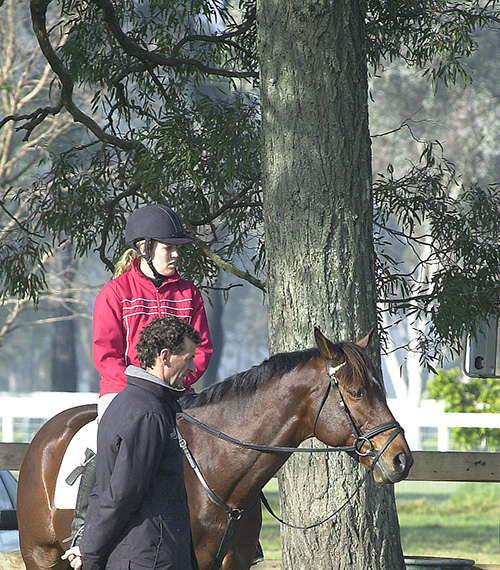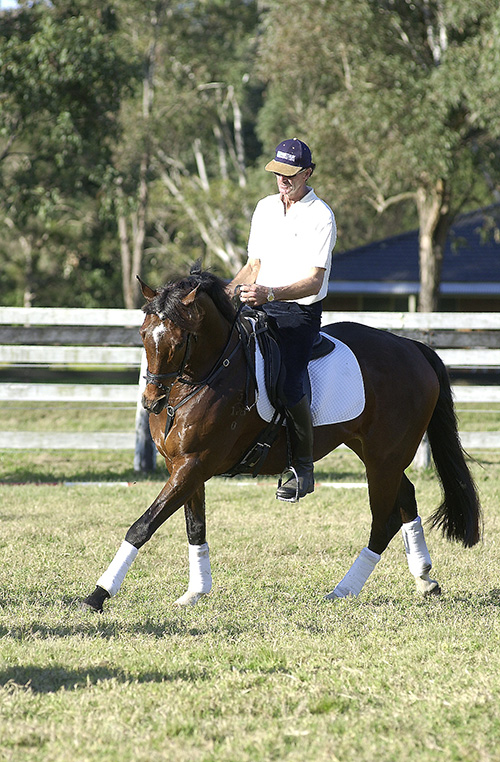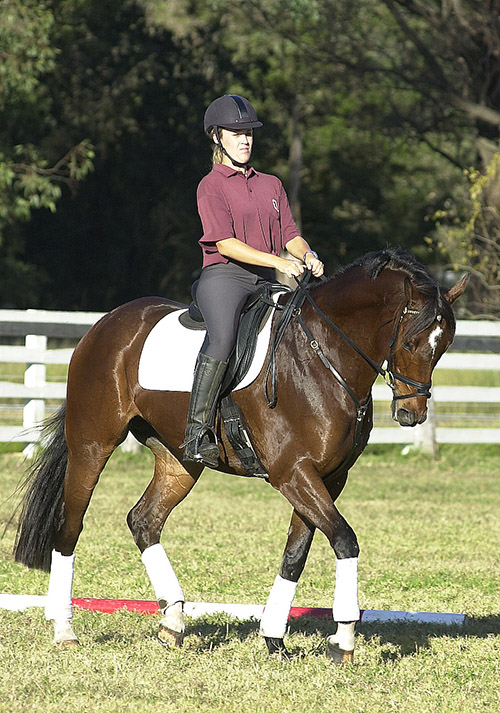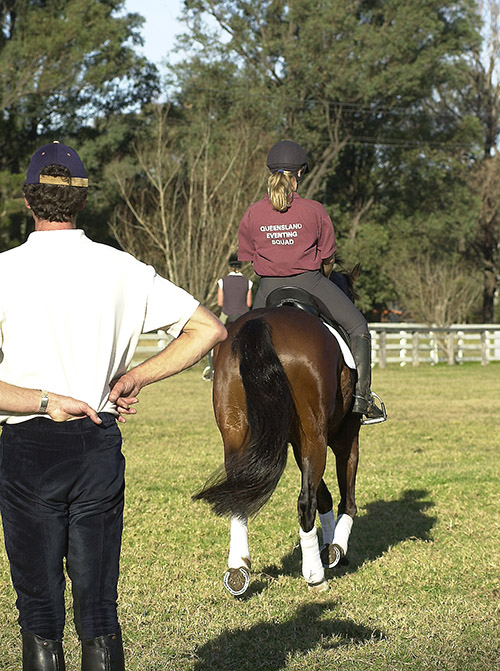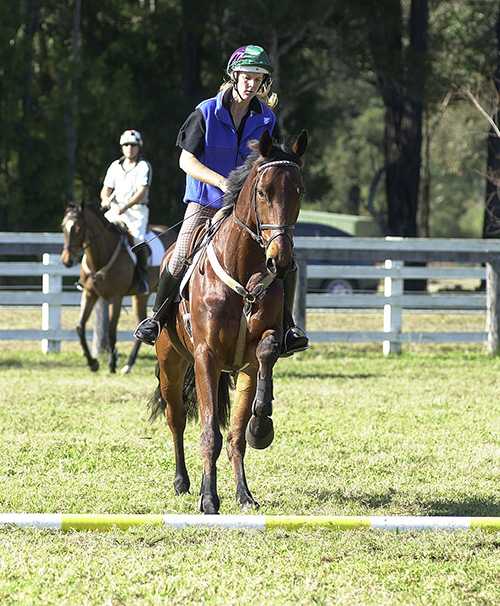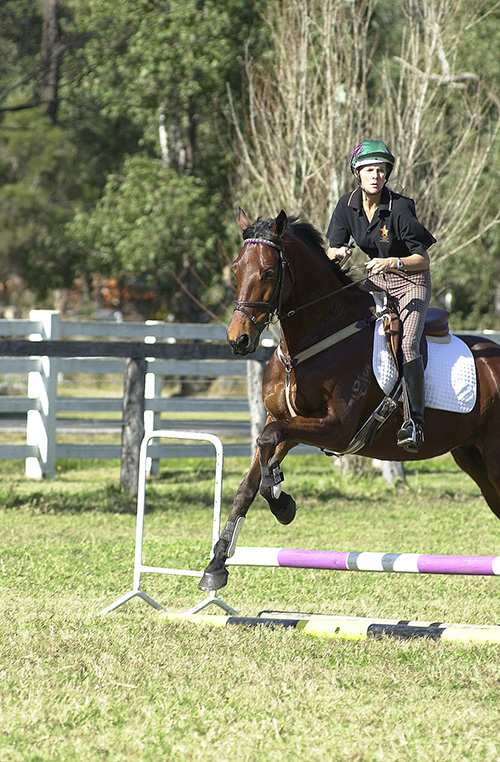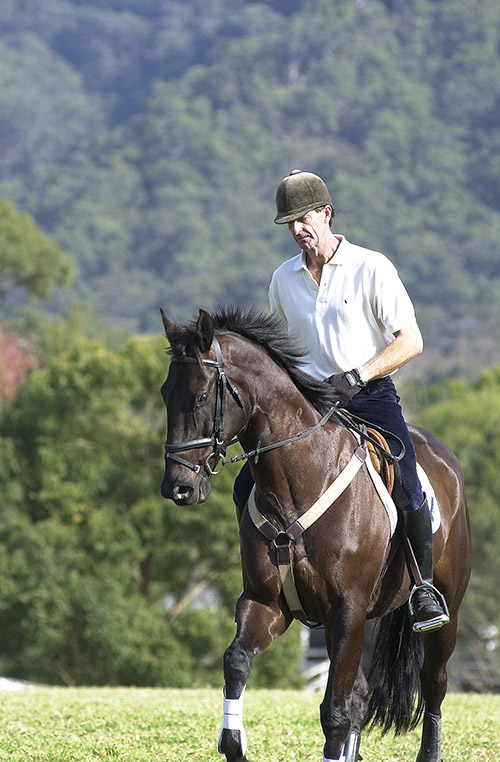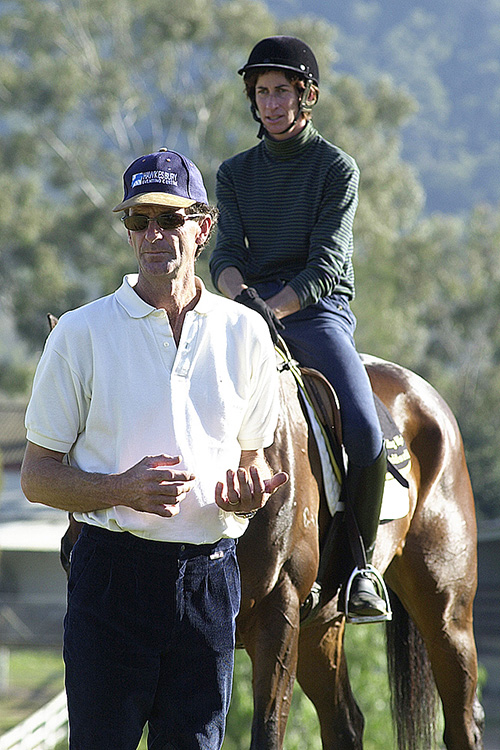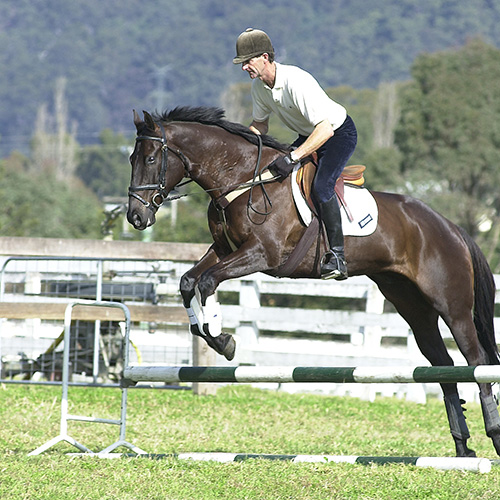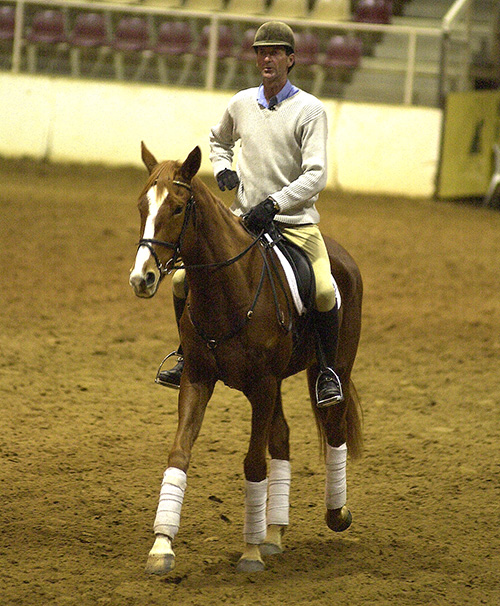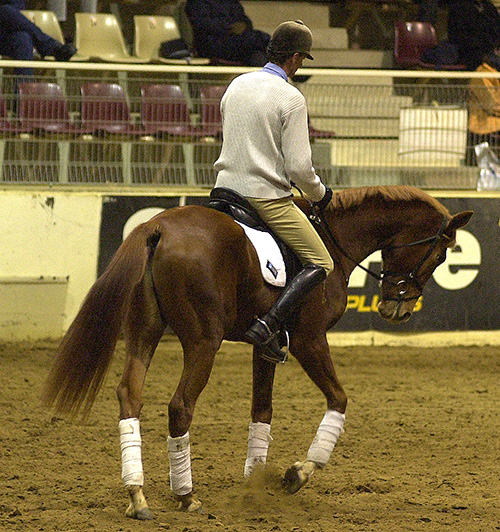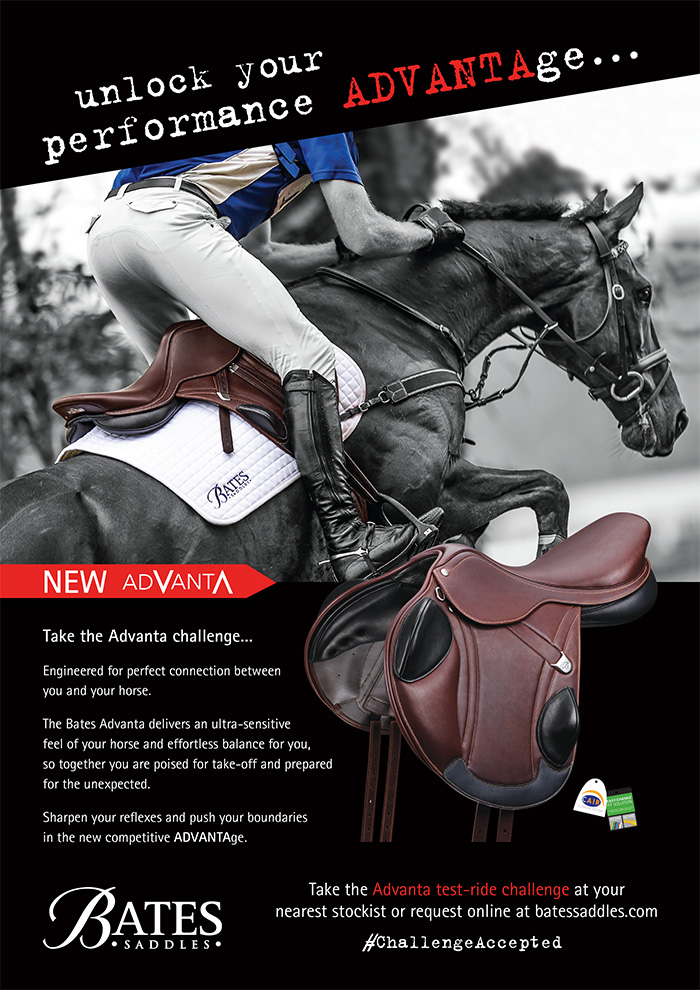Words and photos by Roz Neave
What makes a champion? Some rare indefinable quality, and usually these people are useless as trainers, because their genius comes naturally to them. The Event Rider of the Century, Mark Todd, is an exception. He is also a great teacher, witty, approachable, ready to jump on any horse and with a collection of exercises to make his point to his students.
Mark, like all top horseman, was very particular, “get your reins untwisted.” His first words on position were on the dreaded eventers’ elbow.
“You must have a bend in your elbow for elasticity in contact. Feel his mouth with your hand. Feel you can ride the horse forward with more energy into a soft contact. Half halt if he runs into your hand. You need balance, feel and coordination, looseness through the hips, hands and arms. You must be able to ride forward, straight, and in rhythm. Make the horse supple so he can use his body.”
Mark used a simple square in the paddock for his flat work, but if the exercise seemed simple, it certainly made the riders work.
“Keep the horse’s shoulders in front of you, don’t let the shoulders fall out. Walk straight to the corner, positioning the turn, then ride straight out of the turn. It’s important to control the shoulder through the turn, because it has to come in off the track, not the hindquarters.”
“Make the walk active through the turn. In the walk, use alternate legs, when the horse’s outside leg is back, use your inside leg. Keep in contact with the horse’s side, but quite loose. Then collect the horse around the inside leg for a half pirouette to the inside of our square. Flex the horse in the direction of the pirouette.”
“You don’t want to ride corners like this in a test necessarily, but it’s very important to be able to ride into corner and come out straight. If you have something like a transition from working to medium trot at the quarter marker, you need to have the horse straight so you can make the transition right on the marker, not 3 or 4 strides later. You have to have the horse coming out of the corner with energy. You want the horse in front of your leg through the corner so you don’t come out of the corner and have to push, because that unbalances the horse. You want to be able to come out and just go forward in medium trot.”
“Ride across the diagonal in medium trot. Ride out of the corner straight and forward, make a clear downward transition and ride through the corner.”
“Practise getting your horse sharper to the leg on a circle with two or three forward strides to build energy. Circle him out of the corner and then ride straight, forward and balanced.”
“Leg yield to really get them moving off the leg.”
“Then come back to walk, relax your arms and encourage left right and bigger walk steps.”
It was a lesson about riding corners, structured around very simple exercises, which helped the rider learn those elusive basics which all great trainers talk about.
Next morning in the morning mist, it was showjump time for this group. The session started with 3 or 4 poles on the ground, and riders just trotting around on a big circle, as a group.
“We are just doing the same as we did on the flat yesterday, but now there’s a pole on the ground, the horses are in jump mode with heads in the air, hollow and rushing. You’ve got to train them, and poles are the place to start.”
“When you are working over poles, take your time, keep the rhythm. Don’t ask them to jump over poles, just let them do it by themselves. Keep your line down the middle of the pole, with a balanced trot, use little half halts if they get too fast.”
“Let them think about what they’re doing with their feet. If they trip, don’t tell them off, they learn by doing it.”
Next cantering over the poles…
“Think about what he’s doing under you. Go forward and back within the canter. Now come steady over the first pole and think towards medium over the second, then back again. Watch the pole. Now forward off the turn to the first pole and then sit up and make them wait to the second, half halt wait.”
“Practice riding over poles at home at a forward stride, he’s got to learn to stay relaxed at a forward stride and not go hollow.”
“Come around the corner in canter and over the little rail. They can jump it no problems, but I want you to ignore the fence – think you are riding down the side of the arena, if you’re crooked or stiff or not straight, you correct it. If you let them go like that, that’s the way they’ll stay. Pick a line to follow, find a post in the fence and ride straight.”
“I’d like the canter a bit more together and with a bit more energy. I want you to get the feel of the canter you need from your horse to get the striding you need.”
“It’s not a matter of chasing them to get a distance, it’s a matter of letting them go forward with the leg on. When you’re waiting in front of a fence, you must also keep your leg on. You’ve got to train them to come forward and back.”
“Did you feel as you came around the corner, the right shoulder was out? So the whole line was a bit crooked.”
“You don’t need to just know your course, you need to know how you are going to ride it. Balanced turns, know exactly where you’re going to turn. If you get unbalanced on a turn riding to these poles, ride a circle and re-balance.”
“Your job is to set the rhythm, aiming for even strides keeping the rhythm, staying calm and balanced. Their job is to jump.”
“Make the horse obedient after a pole, it will become a habit and you’ll never have any problems.”
“When you want to open up, don’t come around the corner and then try to get them forward. Establish a rhythm and keep it, then it’s easier on the approach.”
Another super-simple exercise that really showed up weaknesses was a 30 metre circle with three 30cm verticals spread evenly around the circumference.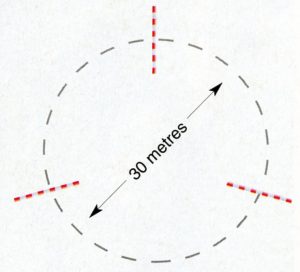
“Let them think about what they’re doing with their feet, let them jump. Don’t throw them at the jump, just sit there and keep the rhythm. With repetition they learn to land on the right leg. Try to remember what it feels like when you get it correct.”
Riders made about six circuits and the exercise was repeated on both reins, and most horses were leading with the inside leg and maintaining balance well by the end of the exercise.
Next exercise was riding a bending line of three little verticals…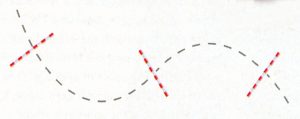
“To ride a bending line you need control rhythm and balance. Don’t angle the first fence – ride a nice smooth line, sit up and use an open rein to turn and encourage them to land on the correct lead. I don’t want to see you just riding the jumps – plan every stride and keep the rhythm. If you want to slow down, sit up and put your leg on.”
NEXT A CLINIC WITH MARK
Mark starting off riding a chestnut gelding that was straight off the racetrack:
“We are going to start out with a real greenie, like a lot of you have to deal with. I’ll just let him wander around for a minute.”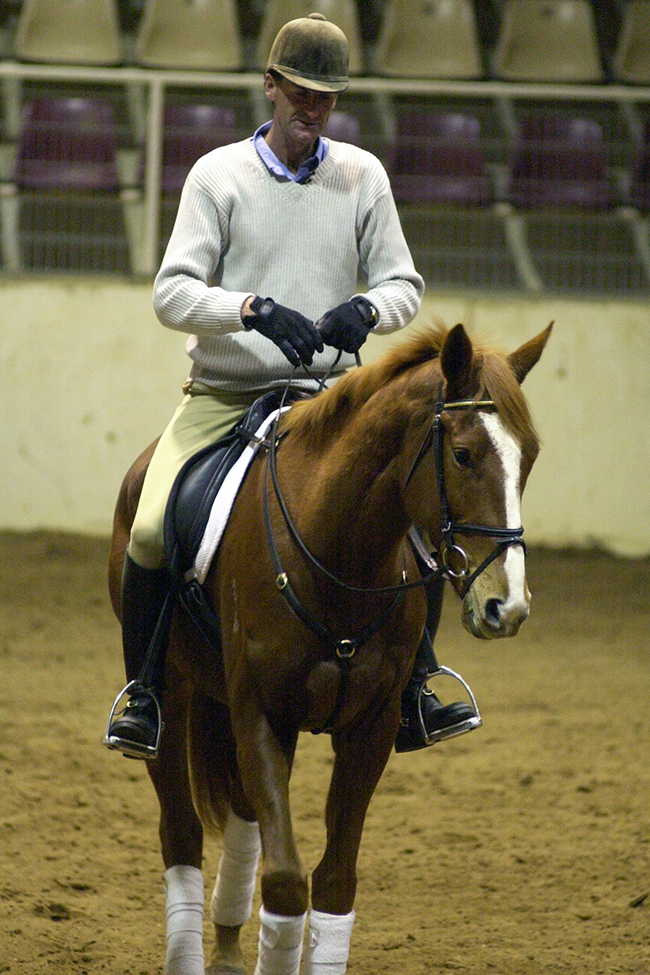
At this stage Greenie was where he was, and overawed by the crowd and lights in the arena. Mark Todd noticed Vicki Roycroft in the stand. He announced to the audience that there was to be a special addition to the program, Vicki would give a showjumping demonstration on the horse instead…
In reality Mark was not in the least fazed by the horse’s confusion, and just keep quietly insisting that Greenie accepted his lower leg.
“When we get a young horse, the first thing is we want the horse to go forward from the leg, then to accept the hand and eventually work in a rounded outline into the rein. Use an open rein, we don’t just pull on the inside rein, because the shoulder drops out. Quietly correct resistances. We don’t want the horse to feel trapped by the hands. Don’t just pull on the reins, close the thigh and reins. As they become used to them, they become sharper.”
“We want to work on getting the horse to run a straight line so he keeps his body straight. We want the horse to become supple, so he can bend through the corners. We want the horse accepting the hands and legs so he can go forward, slow down and stop. Position is very important. Sometimes the combination of a novice rider and a green horse is not a great combination because the two of them are learning together.”
“Start leg yield in walk from the centre line to the outside wall, not vice versa, because horse like to go back to the wall, so it’s easier for them to understand. If he resists too much, try something else. Don’t fight and have a battle. Just ask enough that he can cope. In two or th ree days the horse should be leg yielding without resistance, work away until he does it.”
“With this young horse, just asking it a simple thing like leg yield, he was wildly resisting. While I can’t give into that, I can’t say ‘you sod, you do it’, because he doesn’t know. So you’ve got to be firm enough to say ‘no you can’t do that’, but not go too far and make him flip over backwards.”
“Ride in rising trot when the back is not strong enough. You can introduce canter changes in an informal way quite early, it’s fun to play around. Finish on a relaxed note.”‘
And so at the end of the day, in fact quite late in the evening by this stage, we find out once again, this time from the Event Rider of the Century, it’s all down to good basics.
Mark Todd in a few words…
Watching you work with the riders, and get on and ride their horses, controlled relaxation is what shows through…
It’s relaxed without being lazy – letting the horse relax without him being lazy. Most young riders are trying really hard and they don’t always understand what they are trying to achieve, and particularly if they are on green horses, the immediate reaction, is for their bodies to become tense, and that transmits through to the horses. I try and keep my body as relaxed as I possibly can, and that in turn makes the horses relax more and they in turn are able to stay more soft and supple.
But you’ve got such control of your position…
…from thirty years of riding. It is training, and I’ve had to ride a lot of horses, and I’ve had a lot of horses straight off the track, so you develop a way of riding them. For me, having a fight with them is not the answer. Sometimes you need to be quite firm and strong, but the more relaxed you can be about it, at the same time as being firm. Asking what you want, while knowing the level that the horse is at, knowing how much you can ask. It’s experience that I’ve got over the years, and that’s something you can’t teach, but you can teach the ideas behind the experience.
And how did a person from a little island at the side of Australia become event rider of the century?
Well I certainly didn’t set out to become event rider of the century. I’m a perfectionist by nature, and if I do something I want to do it really well. Riding was my passion so I wanted to do it to the very best of my ability. I didn’t set out saying, ‘I’m going be the best in the world and I’m going to beat this one, and I’m going to beat that one’. I set out to prove to myself that I could be as good as the best. I trained with the people who I thought could help me the most. I watched the best in eventing, and dressage and showjumping. And I continued to do so right through my career, you can never stop learning. It’s interesting to watch, you can always find new exercises to do. So for me it was trying to be the best I could, and if the best was good enough to beat the best, then that was great.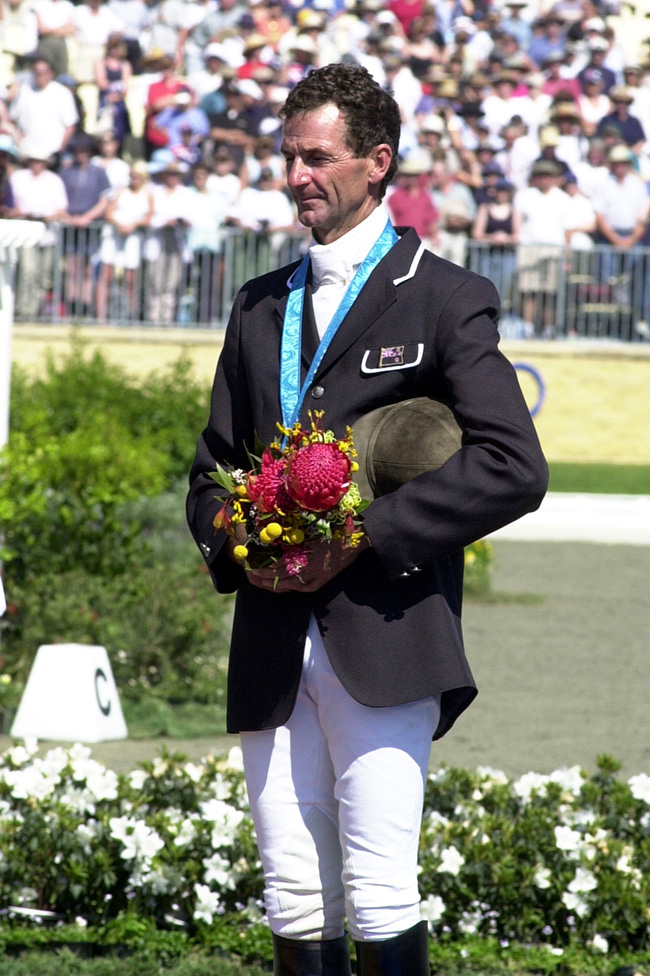
And now do you see you have a role going around doing clinics?
I enjoy doing it. It’s not totally my future, I’ve had over twenty years of competing at top level and one of the reasons I stopped was I’d had enough. I’ve always been keen on racing, and we’re getting into racing and that’s my new career. I also feel that over that time I’ve gained an awful lot of knowledge, and it would be a shame not to help in some way. My future is not going around all the events being a trainer, I’ll be helping the New Zealand lot where I can. The sport of eventing is not about each country against each other, it is essentially, but the sport as a whole throughout the world needs to band together to make it go forward. I’ve been in America this year teaching, I’ve taught in Italy, England, Belgium and Holland, and so I’m not a national trainer for any one team. If I can help, I will wherever I can, to improve the sport as a whole.
This article first appeared in the October 2001 issue.




